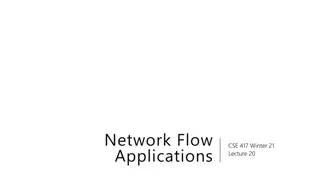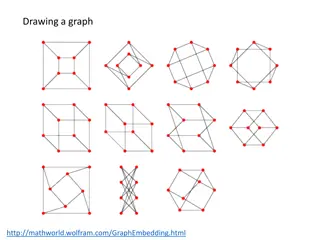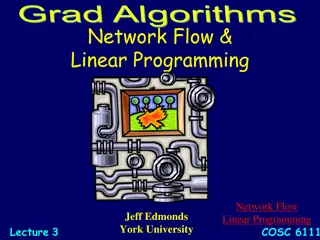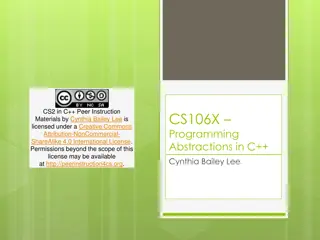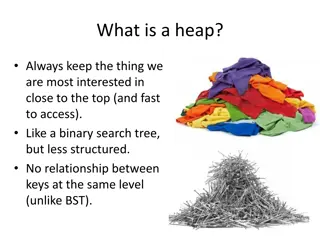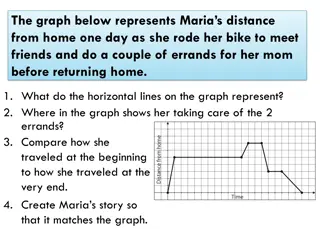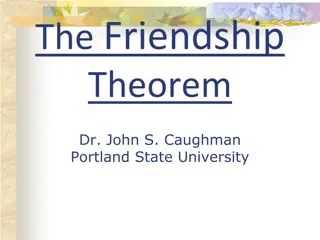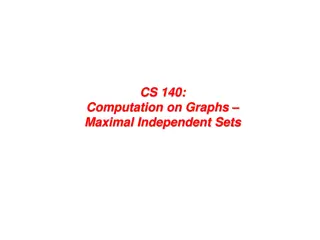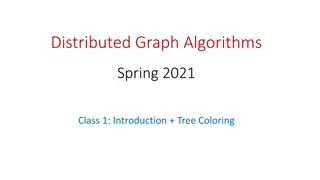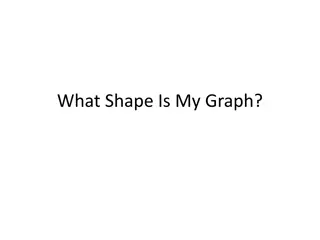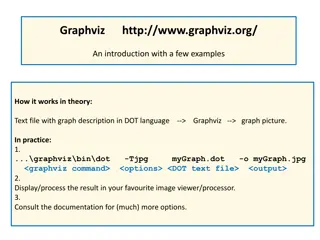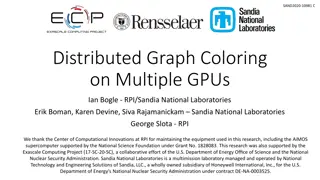Understanding Max-Flow and Min-Cut Problems in Graph Theory
This collection covers the concepts of max-flow and min-cut in directed graphs, focusing on moving water or data packets from a source to a target vertex within given capacities. It explains flow values, finding optimal solutions, and strategies for maximizing flow networks. The visuals aid in grasping the flow movement and the process of determining the maximum flow through paths in a graph.
Download Presentation

Please find below an Image/Link to download the presentation.
The content on the website is provided AS IS for your information and personal use only. It may not be sold, licensed, or shared on other websites without obtaining consent from the author. Download presentation by click this link. If you encounter any issues during the download, it is possible that the publisher has removed the file from their server.
E N D
Presentation Transcript
Max-Flow Min-Cut CSE 417 Winter 24 Lecture 18
Rest of this week Two unrelated-looking problems that are actually closely related! Like LPs, a tool that is very useful for modeling. Today: the problem definitions, how you find an optimal solution Friday: a modeling problem or two.
Max Flow We have a directed graph ?, a source vertex ? and a target vertex ?. We have some thing (water or data packets) we have to send from ? to ?. Every edge has a capacity, it can only handle so many. 2 ? 4 1 ? 2 ? 2 ? 1 2 5 4 ? ? ? 2
Flows A flow flow moves units of water from ? to Water can only be created at ? and only disappear at ?. And you cannot move more water than the capacity on any edge. to ?. 2 ? 4 1 ? 2 ? 2 ? 1 2 5 4 ? ? ? 2
Flows A flow flow moves units of water from ? to Water can only be created at ? and only disappear at ?. And you cannot move more water than the capacity on any edge. to ?. 1/2 ? 2/4 1/1 ? 2/2 ? 0/2 ? 1/1 1/2 2/5 2/4 ? ? ? 1/2
Flows The value value or size Or, equivalently the net flow entering ?. size of a flow is the net flow leaving ? Value of this flow is 5. 2/2 ? 3/4 1/1 ? 2/2 ? 0/2 ? 1/1 1/1 2/5 2/4 ? ? ? 1/1
Finding the Max Flow Idea: find a path that we can push flow along. Start from ?, follow an edge with remaining capacity until you get to ? How much flow can you add? The minimum remaining of the edges we used. Does this work? remaining capacity on any 0/10 0/20 0/20 s t 0/10 0/20
Finding the Max Flow Idea: find a path that we can push flow along. Start from ?, follow an edge with remaining capacity until you get to ? How much flow can you add? The minimum remaining of the edges we used. Does this work? remaining capacity on any 0/10 0/20 0/20 s t 0/10 0/20
Finding the Max Flow Idea: find a path that we can push flow along. Start from ?, follow an edge with remaining capacity until you get to ? How much flow can you add? The minimum remaining of the edges we used. Does this work? remaining capacity on any 0/10 20/20 20/20 s t 0/10 20/20
Finding the Max Flow Idea: find a path that we can push flow along. Start from ?, follow an edge with remaining capacity until you get to ? How much flow can you add? The minimum remaining of the edges we used. Does this work? remaining capacity on any 0/10 20/20 20/20 s t 0/10 20/20
Finding the Max Flow We find a valid flow but it might not be the maximum one. What our first idea found The true optimum 10/10 0/10 20/20 20/20 10/20 s 20/20 s t t 10/10 0/10 20/20 20/20
Finding the Max Flow How would we fix what our first idea found? What our first idea found The true optimum 10/10 0/10 20/20 20/20 10/20 s 20/20 s t t 10/10 0/10 20/20 20/20
Finding the Max Flow How would we fix what our idea found? What our first idea found The true optimum 10/10 0/10 20/20 20/20 10/20 s 20/20 s t t 10/10 0/10 20/20 20/20 We can send extra flow from ? and decrease the flow along another edge with existing flow And we ll still get a valid flow!
Finding the Max Flow How would we fix what our first idea found? What our first idea found The true optimum 10/10 0/10 20/20 20/20 10/20 s 20/20 s t t 10/10 0/10 20/20 20/20
Fixing Our First Idea When can we send flow in a direction? When there is unused capacity OR When there is flow going the other direction we can delete it. Let s update the graph to take that into account. Have an edge weight demonstrate the changeable capacity (the residual )
An Example Graph, with flow Residual Graph 0/10 10 0/20 20 0/20 s 20 s t t 0/10 10 0/20 20 0/10 10 20/20 20 20/20 s 20 s t t 0/10 10 20/20 20
An Example Graph, with flow Residual Graph 0/10 10 20/20 20 20/20 s 20 s t t 0/10 10 20/20 20 10/10 10 20/20 20 10/20 s s t t 10 10 10/10 10 20/20 20
Residual Graph In general: If the original graph has an edge (?,?) of capacity ?, and the flow sends ??,? along (?,?): Include (?,?) in the residual with capacity ? ??,? as long as ? ??,?> 0 (if equal to zero, don t include the edge) Include (?,?) [the edge going in the reverse direction] with capacity ??,? as long as ??,?> 0
Ford-Fulkerson Algorithm While(flow is not maximum) Run BFS in residual graph starting from ?. Record predecessors to find an ?,?-path Iterate through path, finding ? minimum residual capacity on path. Add ? to every edge on path in flow Update residual graph
Ford-Fulkerson Algorithm While(true) Running Time:? ?(?) per iteration. Number of iterations? Run BFS in residual graph starting from ?. Record predecessors to find an ?,?-path If you don t reach ?, break. //otherwise you can still augment Iterate through path, finding ? minimum residual capacity on path. Add ? to every edge on path in flow Update residual graph Assuming ? ?(isolated vertices won t affect the flow, so this is reasonable).
Ford-Fulkerson Algorithm If we have all integer capacities at the start... The residual graph will always have integer capacities. Why? The minimum capacity on the first path is an integer. So we subtract or add integers to the residual graph. And the result is more integers! So in every iteration we add at least 1 unit of flow!
Ford-Fulkerson Algorithm While(true) Running Time:? ?(?) per iteration. Number of iterations? ?(?), where ? is the value of the maximum flow. Total ?(??) Run BFS in residual graph starting from ?. Record predecessors to find an ?,?-path If you don t reach ?, break. //otherwise you can still augment Iterate through path, finding ? minimum residual capacity on path. Add ? to every edge on path in flow Update residual graph
Wait?? We haven t seen a running time before that depends on the answer answer Normally, we want the running time directly in terms of the input. There are tricks to speed up Ford-Fulkerson so you don t take too long if ? is really big. Some optional content about this at the end of this deck.
Whats a Cut? For directed graphs (like we have here) An (?,?)-cut, is a split of the vertices into two sets (?,?) So that ? is in ?, ? is in ?, and every other vertex is in exactly one of ? and ?. The capacity of a cut (or size of a cut) is the capacity of the edges going from ? to ?(don t count capacity from ? to ?).
An Example Graph, with flow Residual Graph 10 10/10 20 20/20 10/20 s s t t 10 10 10 10/10 20 20/20 We can t get from ? to ? anymore in the residual graph. We re done! That s a maximum flow. But why?
An Example Graph, with flow Residual Graph 10 10/10 20 20/20 10/20 s s t t 10 10 10 10/10 20 20/20 Cut is (?, ? ?) (i.e. ? on one side, everything else on the other) Edges from ? to everything else? Capacity 30 We can t get more than 30 units of flow from ? to ?. Because it all (simultaneously) must cross from one side to the other.
How Do We Know? How do we know the algorithm is done? When we can t we get from ? to ?? We ve cut ? and all the vertices you can reach from it on one side and ? and all the vertices ?can t reach on the other. cut the (residual) graph. Take a look at the edges spanning the cut in the original graph. In our first graph, that capacity was equal to the value of the max flow. .
Finding the min-cut Maintain the residual graph. When you search from ?and can t get to ?: ? and everything you can reach from ? is on one side of the cut ?and everything you can t reach from ? is on the other side.
Another Example We started lecture with this flow. What s the residual graph? What s the cut? 2/2 ? 3/4 1/1 ? 2/2 ? 0/2 ? 1/1 1/1 2/5 2/4 ? ? ? 1/1
Another Example Pollev.com/robbie ? Residual ? ? ? ? ? ? Flow 2/2 ? 3/4 1/1 ? 2/2 ? 0/2 ? 1/1 1/1 2/5 2/4 ? ? ? 1/1
Another Example 2/2 ? 3/4 1/1 ? 2/2 ? 0/2 ? 1/1 1/1 2/5 2/4 ? ? ? 1/1 ?,?,?,? , ?,?,? is the cut in the residual graph. What edges span? ?,? , ?,? , ?,? ,(?,?) Total capacity? 5. What s the value of the flow? 5
Max Flow-Min Cut Theorem Max-Flow-Min-Cut Theorem The value of the maximum flow from ? to ? is equal to the value of the minimum cut separating ? and ?. No proof, but here s some intuition: Every cut is an upper-bound on the value of the flow (you can t have the total flow value higher than the cut). Cut will be saturated (i.e. full flow going through all the edges) otherwise residual graph will have another edge. So flow and cut are equal values.
So What? Max-flow and min-cut are each interesting algorithmic problems. They were first studied in the 1950s The U.S. military wanted to know how much the Soviets could ship on their rail network. And also which rail lines they would target to disrupt the network.
So What? Great quick check for if you ve found the maximum flow (or min-cut). Check the other and see if the value is the same! We ll see examples next time of max-flow used for modeling. In those cases the min-cut can be interpreted as a barrier to a good assignment. It s also a nice example of duality If you know what a dual linear program is flows and cuts are dual LPs. duality
Applications of Max-Flow-Min-Cut Max-Flow and Min-Cut are useful if you work for the water company But they re also useful if you don t. The most common application is assignment problems. You have jobs and people who can do jobs who is going to do which? Big idea: Let one unit of flow mean assigning one job to a person.
Hey Wait Isn t this what stable matching is for? Stable matching is very versatile, and it lets you encode preferences. Max-flow assignment is even more versatile on the types of assignments. But there s not an easy way to encode preferences.
Example Problem You and your housemates need to decide who is going to do each of the chores this week. Some of your housemates are unable to do some chores. Housemates: 1,2,3 Chores: A Arrange furniture, clean the B Bathroom, C Cook dinner, do the D Dishes Housemate 1 is unable to arrange furniture, 2 is unable to cook.
Example Problem Housemate 1 is unable to arrange furniture, 2 is unable to cook. Vertex for each housemate and chore. Edge if the housemate could could do the chore A 1 B 2 C 3 D
Example Problem Housemate 1 is unable to arrange furniture, 2 is unable to cook. Vertex for each housemate and chore. Edge if the housemate could could do the chore A 1 B 2 C 3 D
Example Problem Housemate 1 is unable to arrange furniture, 2 is unable to cook. Vertex for each housemate and chore. Edge if the housemate could could do the chore A 1 B 2 C 3 D
Example Problem Housemate 1 is unable to arrange furniture, 2 is unable to cook. Vertex for each housemate and chore. Edge if the housemate could could do the chore A 1 B 2 C 3 D
Example Problem Idea: Flow from 1 to ?means make housemate 1 do chore B. Every chore needs to be done (by one person). Every person needs to do at most two chores. A 1 B 2 C 3 D
Example Problem Idea: Flow from 1 to ?means make housemate 1 do chore B. Every chore needs to be done (by one person). Every person needs to do at most two chores. A 1 dummy source B 2 t s C 3 dummy target D
Example Problem Idea: Flow from 1 to ?means make housemate 1 do chore B. Every chore needs to be done (by one person). Every person needs to do at most two chores. A 1 ?/1 ?/1 B 2 t s ?/1 C ?/1 3 D
Example Problem Idea: Flow from 1 to ?means make housemate 1 do chore B. Every chore needs to be done (by one person). Every person needs to do at most two chores. A 1 ?/1 ?/2 ?/1 B ?/2 2 t s ?/1 ?/2 C ?/1 3 D
Example Problem What are the capacities for the middle edges? Could make them 1 (make sure you don t get two units of cooking All our requirements are already (implicitly) encoded. So could make them instead. A 1 ?/1 ?/2 ?/1 B ?/2 2 t s ?/1 ?/2 C ?/1 3 D
Example Problem Find a max flow And read off the assignment! Full color: 1 unit of flow, faded: 0 units of flow 1 cleans the bathroom and does the dishes, 2 arranges furniture, 3 cooks. A 1 1/1 2/2 1/1 B 1/2 2 t s 1/1 1/2 C 1/1 3 D






